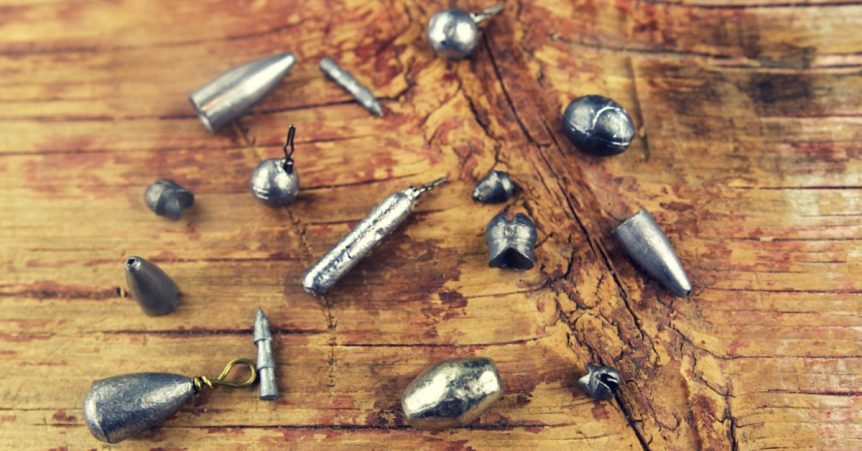Karl’s Guide To Selecting The Right Sinker Weight
No matter what species of fish you target, you should have your tacklebox stocked with sinkers.
A sinker is basically a weight made from lead, brass or tungsten steel that sinks your bait down to bottom-hugging fish. Sinkers come in a wide range of weights and shapes for anglers to use for various fishing tactics. Here are six types of sinkers available at Karl’s the market and some tips on when and where each type of weight works best.
No Roll Sinkers

I remember when I was a kid my Dad would use this type of sinker to tight line for catfish on the Mississippi River. These flat, tear-shaped sinkers are ideal for fishing in heavy current because the weights lay flat on the bottom to prevent the current from rolling them. The no-roll sinker is a slip weight which allows you to feed line through it and attach the line to a swivel followed by the leader line with the bait hook similar to a Carolina rig for bass. This setup works best for fishing in strong current for catfish or sturgeon on the big rivers such as the Mississippi, Missouri, and Columbia.
Dropshot Stick Weights

The most popular dropshot weights are the ball-shaped sinkers, but there are times when you need a stick-shaped weight for catching bass around specific types of cover. The stick weight can be considered a finesse sinker because its slender shape allows it to slide through grass, brush or other thick cover without snagging. You can also drop shot with this weight along bottoms with boulders because it slips easily through the rock crevices whereas the ball-shaped weight tends to roll and get stuck in narrow cracks. The stick weight is also ideal for drop shotting in heavy current because the cylinder shape allows the weight to drift with the flow and tick the tops of the rocky bottom without rolling down into the rocks where it can get snagged.
Egg Sinkers
These are my favorite sinkers for Carolina rigging for bass. The egg-shape sinker is ideal for dragging along mud, sand or gravel bottoms where it stirs up silt and debris to attract a bass’ attention to the bait trailing the weight. As the weight bumps bottom, the shape of the sinker allows you to keep contact with the bottom better than other types of sinkers. Keeping constant contact with the bottom also helps you determine the type of bottom you are fishing. I use a lightweight sinker such as a 1/4-ounce weight for Carolina-rigging at depths of less than 10 feet and switch to 3/4- or 1-ounce sinkers when I want to drag a rig in the 15- to 25-foot range.
Split Shot Sinkers

I use split shots for a variety of fish including bass, bluegill, crappie, and trout. Split shots are usually bb-sized or larger round weights that can be crimped on the line at various lengths above your hook. These small baits are best for using in shallow-water applications or for weighing down a bait set below a bobber. When fishing a bobber rig, I use the smallest weight possible for fishing a worm or cricket so bluegill will not feel the resistance of the weight when it inhales my bait. One of my favorite tactics for catching pressured spawning bass in murky shallow water is the split-shot rig. I pinch a Number 4 (about 1/8 ounce) split shot about 1 foot in front of a plastic lizard and drag it slowly along a gravel bank to tempt finicky bass on beds.
Casting Sinkers

I have used these bell-shaped sinkers effectively for drop-shotting for bass, but this style of sinker works great for shore anglers because it casts well allowing them to throw their baits long distances. When fishing from a boat, you can use the sinker on a three-way rig consisting of a three-way swivel with one eyelet for the main line, the second loop for a drop line attached to the sinker and the final loop for a leader with a lure or live bait attached. The round shape of the weight reduces the risk of snagging so the three-way rig is effective for bouncing along the bottom when drifting or trolling in open water.
Pyramid Sinkers

The Ancient Egyptians believed in Pyramid Power and you can too when you use these sinkers with an inverted pyramid profile. This sinker works best in fast currents because its streamlined shape causes it to sink quickly and the weight’s flat edges prevent it from rolling in the strong flow. When fishing in sand or mud bottoms, the sinker will bury itself in the soft bottom to keep the bait in the same place. The sinker’s ability to hold fast in current makes it the top choice of striper anglers for surf fishing.


